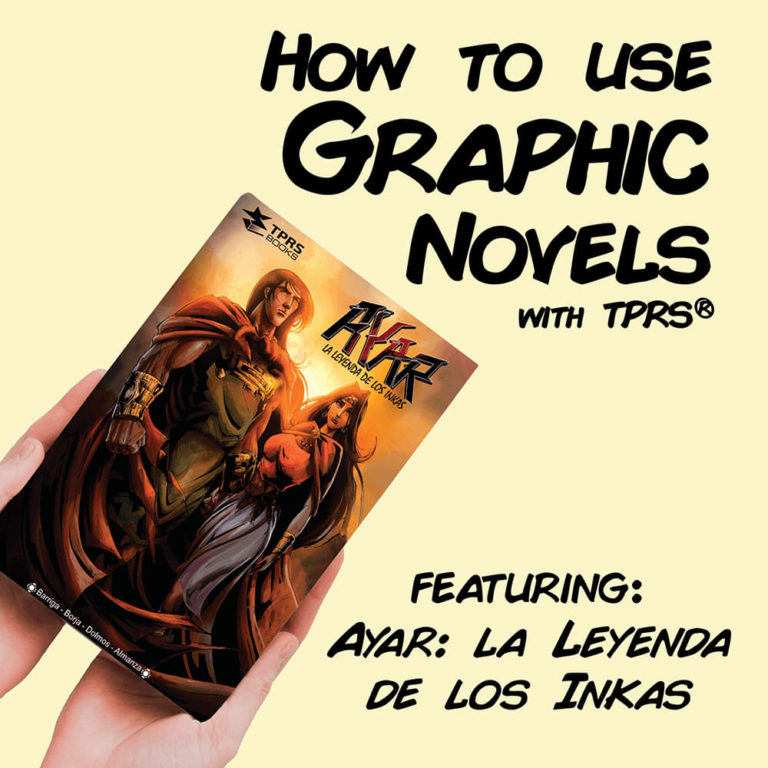
Did you know that TPRS® can be used with graphic novels in class?
In this post, we’ll discuss 5-10 tips and tricks to use TPRS® when teaching with a graphic novel!
Let’s use the graphic novel: Ayar: la leyenda de los Inkas as an example. 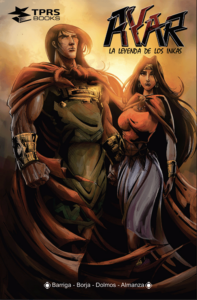
If you aren’t aware of this product, it is an authentic Peruvian text by the company TAWA.
In the book, Wiracocha, the Creator, established balance and peace in the three planes of existence: Hananpacha, Kaypacha, and Ukjupacha. When Huallullo Carhuinchu leaves Hananpacha to turn our world to darkness, Inti sends his sons, the AYAR brothers to restore balance and establish the future Inkan empire. Will they be able to defeat their uncle and save Kaypacha from darkness?
This story has been simplified from the original language so Spanish learners can appreciate it even more! It would be a great addition to your classroom libraries for level 3 and 4!
And without further ado, let’s see the 5 tips for using TPRS® when teaching with a graphic novel!
For this idea, the power of TPRS® can be used as a pre-reading strategy. The way this works is that you can take the entire graphic novel and look at the vocabulary list (provided in the glossary). Book glossary available on our website here.
Once you have looked through the glossary, you can then break down the vocabulary in the book into categories such as:
The “need to know” category consists of words that students need to know before reading the story. These would most likely include high frequency language that will guarantee the students’ success when reading the novel. Other words included in this list might be words that occur throughout the book that are very important to the story. This would be considered the language students must know and have in a strong and healthy way before reading which will only be reinforced by reading the graphic novel.
The “nice to know” category will contain words that are not as necessary as the first category, but could still be helpful for students to know. These are enrichment words that could still be useful to the students’ vocabulary.
The “unnecessary” category will be anything else. This could include cognates that students aren’t going to need to understand ahead of time because they will be able to read them. It could also include words that are not R.I.C.H. (repetitive, interesting, comprehensible, high frequency).
Once these lists are generated, a teacher can:
Then once the teacher has pre-taught these words sufficiently so the students’ mental representation is strong and healthy on these words, then the teacher can start using the graphic novel! They could read the graphic novel as a class novel or in Silent Sustained Reading (SSR).
Many teachers of upper levels have created units to deliver input to their students. One such example would be a myths and legends unit. Myths and legends are in every culture and often served as a way to teach moral lessons or wisdom.
If a teacher were to explore myths and legends in various Target Cultures (or throughout the world), Ayar: la leyenda de los Inkas could fit in very well to that unit because the authors traveled throughout Peru and gathered stories from the oral tradition, which they then synthesized into a narrative that ties many of those beliefs into one incredible story.
Some themes to explore in Ayar: la leyenda de los Inkas (and a larger unit) could be: 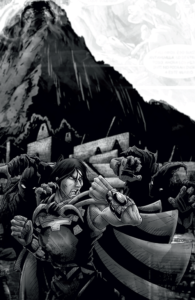
As you could see, this would be fascinating to discover with students and compare to creation myths students are familiar with as well as other beliefs in other parts of the world.
This graphic novel is so full of historic, mythological and cultural references of Peru, it would be a great point of entry for bringing those things into the classroom.
Concepts that are specific to Peru in this book to further explore could be ancient civilizations as well as characters such as:*
*The authors of the comic might have chosen alternate spellings for some of these things as they are most likely transliterations of Quechua.
And these are just some of the many things included in the two volumes of the Ayar saga to further enrich the students’ understanding of Peru and its ancestors!
Ayar la leyenda de los inkas, contains difficult situations as well as something very relatable: flawed characters.
The Ayar brothers themselves go through various trials in their attempts to defeat Qanla. But even Qanla’s story is about the corruption of mankind. As a teacher, here are some possible discussion questions and ideas for a deeper conversation in the target language. 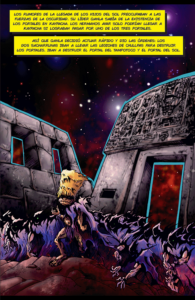
And these are just some of the many things that one could discuss from the two volumes of the Ayar saga!
As you might see so far, Ayar la leyenda de los inkas, is very versatile depending on what you want to do in your classes! But consider even using it to learn about your students. For example, while reading through a section of the book, consider using that to turn the conversation over to learning about your students’ lives.
For example, when Tambo betrays the Ayar brothers, you could talk to students about a time they felt betrayed or a time they betrayed someone. It could be a real discussion or a fictional one depending on your classroom culture. But either way, it could be an interesting glimpse into your students’ lives to further be enriched by discussion and to build a classroom community.
Another example could be when Manco is the only brother left, you might ask, have you ever had a time in life where you felt like the only one trying to do the right thing? Or, have you ever felt alone?
Personalization is as simple as asking questions that you, as a teacher, are interested in the answers to, and then continuing with follow-up questions to get to know your students and help them get to know one another.
There are numerous moments in the book that could be dramatized in Ayar la leyenda de los inkas. Consider the parts where:
For the first one, there are times when characters are in situations (especially in battles where they are disrespecting one another, that could be fun to act out.
In regards to acting out a scene, this graphic novel is jam-packed with action, so many of the scenes could be acted out as the battles. That would especially be fun for some of the students to act out whether they be the hero or the villain. Consider having props for the students to help them build more into the fantasy while you read along.
Both of these scenarios can be further extended by remembering that your student actors can also be interviewed as parallel characters.So don’t be afraid to ask questions to the actors as their characters for more information. This could include their wants, hopes, desires or why they do something a certain way. Then you could also extend dialogue out further by adding in additional phrases.
Ayar la leyenda de los inkas, like other graphic novels, could be used as a class novel. 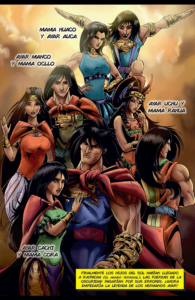
In this model, you could read a predetermined amount of pages together as a class per session and follow through with personalization, as a point of entry to culture, discussion, or dramatization as mentioned in previous sections to enrich the reading experience as a class.
Ayar la leyenda de los inkas, like other graphic novels, could be used as a book to read during Silent Sustained Reading (SSR).
In SSR, students all have a copy and read through the book at their own pace. You could have students read a certain section silently in class or as homework. Then you could ask questions to them after they read or just allow the novel to serve as enrichment.
With all of the wealth of content in this graphic novel, you could easily create a quarter or semester’s worth of content that culminates in an assessment over content!
And that's probably just scratching the surface of what you can do with graphic novels in class and more specifically Ayar: la leyenda de los inkas! We hope you find success in teaching with it!